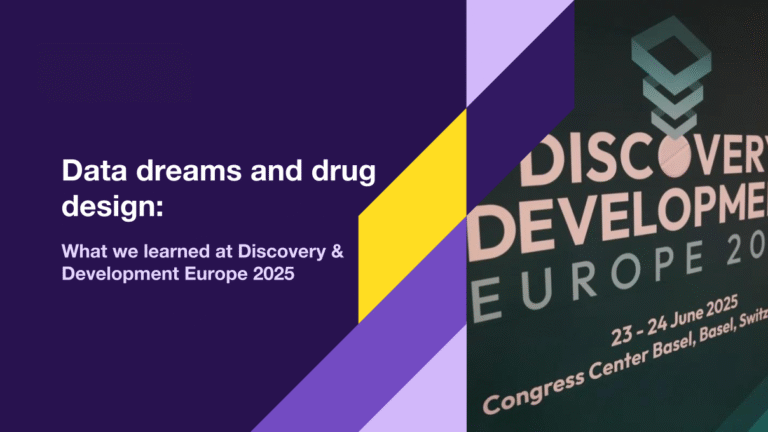Last week, Ardigen had the pleasure of co-hosting a webinar together with our partner Automata titled Building Lab-in-the-Loop Ecosystems: From Concept to Application. Automata, a leader in lab automation, is dedicated to making automation accessible to life sciences labs, and we are supporting this goal by providing data-driven insights and scalable infrastructure.
Led by Rui S Campo, Product Director at Automata, and Tomasz Jetka, Director of AI at Ardigen, the discussion centered around integrating AI and automation into experimental lab environments. This webinar is part of Automata’s Lab Futures Forum, a series of monthly live-streamed events covering topics around AI-driven drug discovery and pharmaceutical innovation produced in cooperation with Bits in Bio, a community of researchers building software for science.
In this session, Tomasz Jetka explored the practical steps of building lab-in-the-loop ecosystems, using real-world examples to demonstrate how integrating in silico approaches with automated lab experiments can streamline workflows, optimize drug discovery, and accelerate pre-clinical programs. Drawing on extensive experience, he showcased Ardigen’s successful partnerships with pharma and biotech that span across the drug discovery pipeline.
We’ve summarized the topics discussed during the webinar below, but we also encourage you to watch the full recording here:
What is a lab-in-the-loop ecosystem?
As biomedical research becomes more and more data-driven, every step of the drug discovery process can benefit from insights. A lab-in-the-loop approach integrates AI-powered decision-making into laboratory workflows to enhance the efficiency of experimental cycles and accelerate discovery. Experimental data is analyzed to generate insights and improve the design of subsequent experiments, creating an iterative process that fuels innovation.
Campo emphasized that modern labs have to process an enormous number of samples, which demands a different approach to both data analysis and experimental design. In order to handle large and complex throughputs, today’s lab managers have to work closely with data scientists to optimize laboratory processes. The lab-in-the-loop approach employs AI to handle data flow, extract insights, and adjust experiments automatically, reducing reliance on manual oversight and improving research efficiency.
Bridging wet lab and computational sciences
Effective lab-in-the-loop systems depend on an integrated approach, combining AI with domain-specific knowledge, high-throughput experimental setups, and robust screening methods. Such workflows can significantly accelerate innovation. For drug discovery research, this means decreasing time-to-insight, reducing the cost of drug development and improving the chances of success in developing effective treatments.
The practical steps of making this vision a reality involve creating a unified platform to align wet-lab and computational scientists, promoting collaboration for data-driven insights and efficient experimental design. Ardigen’s experience shows that establishing an ecosystem that supports cross-disciplinary teamwork is essential for streamlining processes and improving organizational efficiency.
Jetka presented several case studies of how Ardigen has helped companies successfully implement lab-in-the-loop ecosystems. Below, we summarize a few key takeaways from the discussion and invite you to watch the full webinar for an in-depth exploration, including an interactive Q&A session.
Analyzing content-rich data
One example of a promising application of lab-in-the-loop approaches is using AI to analyze high-content screening (HCS) data, such as Cell Painting assays. High-content imaging assays are low-cost, easy to set up and automate, and offer detailed biological information, making them ideal for high-throughput screening campaigns. Using AI methods to enhance the analysis of rich datasets from HCS studies can help researchers arrive at the right conclusions faster and reduce the cost of screening by zeroing in on the most promising samples.
HCS assays like Cell Painting have demonstrated impressive results for improving small-molecule drug discovery, especially when coupled with AI/ML. The availability of public data repositories, such as the JUMP-CP consortium, facilitates model training and serves as a great starting point for the exploration and application of HCS methods.
By utilizing AI to automate data processing and analysis, researchers can extract more information and access insights much faster. For example, HCS data provides valuable information for small molecule screening campaigns. Using multimodal data, including HCS and chemical structure data, improves the prediction accuracy compared to using chemical structures alone. When combined with a standard lab-in-the-loop approach, this method can be very powerful.
Future outlook
While AI methods undeniably enhance the drug discovery process, using AI models alone is not nearly as powerful as combining it with optimized experimental workflows. Despite progress in developing sophisticated models, black-box AI methods (like de novo design of antibodies) still lack real-world therapeutic applicability. The biggest breakthroughs can be achieved by combining advanced AI with experimental expertise, iterative testing, and deep domain knowledge to identify viable drug candidates.
At Ardigen, we specialize in integrating computational and biological expertise to help our partners achieve the best results. If you are interested in learning how you can successfully implement a lab-in-the-loop ecosystem at your organization, reach out to one of our experts to discuss your project.




